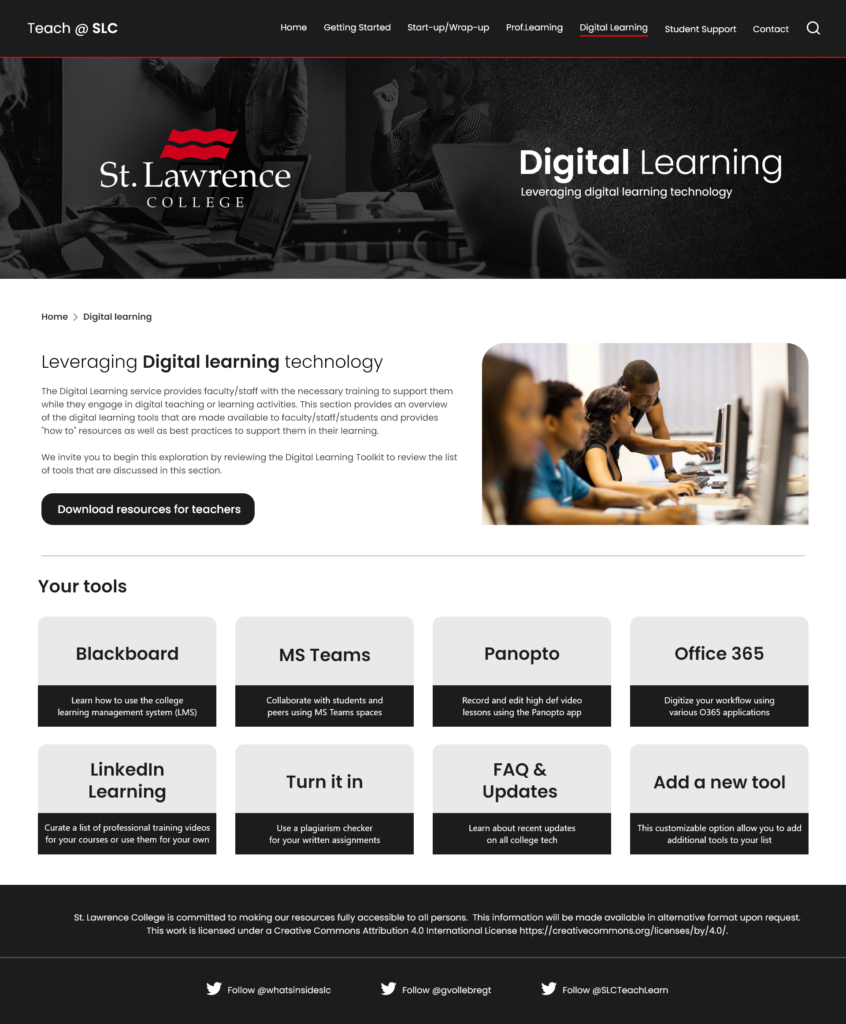
Teach at SLC Redesign.
Client: St.Lawrence college, Ontario, Canada
Teach @ SLC serves as a crucial resource platform dedicated to supporting newly joined and returning faculty members of St. Lawrence College (SLC) in navigating college's digital learning resources. This project focuses on conducting moderated usability tests and implementing iterative design processes to enhance the platform's efficiency and effectiveness. Through these efforts, we aim to identify key challenges faced by faculty members when utilizing resources on the platform. By streamlining navigation, improving content organization, and optimizing the overall user experience through iterative design, our goal is to transform Teach @ SLC into a more intuitive and valuable platform for faculty members. Ultimately, this enhancement will contribute to enhancing the teaching and learning experience at St. Lawrence College.
Let's Get Started.

Teach @ SLC’s original design features a cluttered layout, complex navigation,
and limited visual elements, with inconsistencies across nested digital learning pages.
Scope Of the Usability Testing.

The scope of conducting a usability test on Teach at SLC was determined by focusing on critical pages such as the landing page, digital learning page, and third-level pages within the digital learning section. Key aspects evaluated included layout, visuals, and navigation to uncover usability issues and enhance the overall user experience for faculty members. This approach ensures targeted improvements aligned with user needs and platform objectives.
The Test Script & Task List

The testing script for evaluating Teach at SLC’s website was thoughtfully crafted to guide participants through realistic scenarios and tasks. It began with pre-test questions to understand participants’ backgrounds and experiences with digital platforms and Teach at SLC. Participants were then introduced to the objectives of the usability test and provided with a scenario to simulate real-world use of the website. The script included a series of tasks designed to assess different functionalities and aspects of the website, such as booking meetings, filling out forms, locating information, and downloading resources. Each task was carefully selected to uncover usability issues and gather meaningful feedback on the user experience. Participants were encouraged to think aloud during tasks, allowing them to provide insights into their interactions and thought processes. Overall, the testing script provided a structured framework for conducting the usability test and gathering valuable insights to inform design improvements.
The Recruitment Process.
The recruitment process for the usability testing was challenging. With the assistance of Prof. Sherry Taylor, the UX design program coordinator at St. Lawrence College, I sent E-mail invitations to approximately 10 faculty members for the usability test. Despite the outreach efforts, I ultimately secured participation from only three participants. Their involvement was instrumental in gathering valuable insights and feedback to improve the usability of Teach at SLC. This experience underscores the importance of persistence and collaboration in engaging stakeholders for user-centered design initiatives.
The Test - Phase 1.

During the first phase of the usability testing with the current Teach @ SLC website, a moderated and in-person approach was used to gather detailed feedback from participants. The testing session involved direct observation of participants’ interactions and behaviors, with notes taken throughout to capture insights and usability issues. The moderator guided participants through tasks, asked clarifying questions, and facilitated real-time feedback collection. This initial phase focused on assessing the usability of the existing website, aiming to identify pain points and areas for improvement to inform the redesign process.
Phase 1 Results & Analysis.
Results of Pre-Test Questions.

Results of Single Ease Questions (SEQ)

Results of Post-Test Questions (Qualitative Data)

Quantitative Metrics

Design Decisions.
Key improvements focused on enhancing information accessibility by reducing content layers and highlighting frequently accessed resources. Consistent button design was implemented to address user confusion, ensuring intuitive navigation. Information architecture was refined to prevent misplacement of content under incorrect categories, improving user guidance. Additionally, content maintenance and updates were prioritized to address issues with outdated or misleading information, fostering user trust and engagement. These decisions collectively aimed to improve usability, clarity, and effectiveness for faculty navigating the platform.
Redesigned Teach @ SLC (Prototype)

Redesigned Pages





The Test - Phase 2.

In the second phase of the usability testing for the redesigned Teach @ SLC web pages, three additional participants were recruited to evaluate the updated design. Building on insights gained from the initial testing phase, the same set of tasks and scenarios were administered to participants using the new website design. This approach allowed for a comparative analysis between the original and redesigned versions, focusing on improvements in usability, navigation, and overall user experience. By conducting the test with a fresh group of participants, we aimed to gather diverse perspectives and validate the effectiveness of the design changes. The iterative nature of this testing process enabled us to refine the website based on user feedback, ultimately striving to create a more intuitive and user-friendly platform for faculty members at St. Lawrence College.
Phase 2 Results & Analysis.
Results of Pre-Test Questions.

Results of Single Ease Questions (SEQ)

Results of Post-Test Questions (Qualitative Data)

Quantitative Metrics

Test Results Comparison & Project Outcome.

The comparison between Phase 1 and Phase 2 of usability testing for the redesigned Teach @ SLC website reveals substantial improvements in user satisfaction and usability. Participants in the second phase showed enhanced satisfaction and ease in completing tasks, as evidenced by improved ratings across various categories (Q1-Q10) and a notable increase in System Usability Scale (SUS) score from 75.83 in Phase 1 to 91.6 in Phase 2. The Net Promoter Score (NPS) also improved significantly from a neutral 0 in Phase 1 to a positive 66.67% in Phase 2, indicating increased user advocacy and satisfaction with the updated design. These findings underscore the effectiveness of iterative design based on user feedback, resulting in a more intuitive and user-friendly Teach @ SLC platform for faculty members at St. Lawrence College.